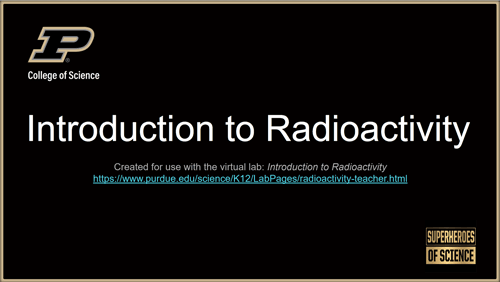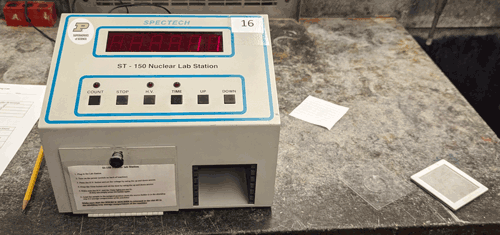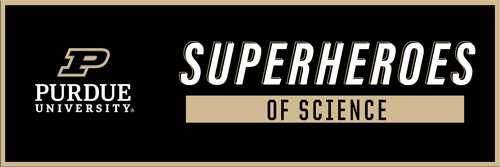Introduction to Radioactivity
Lesson Overview
In this lesson, students will investigate the nature of radioactivity and the effect of both distance and shielding materials on different radioactive sources using a Geiger-Muller tube with a counter, (generally referred to as a nuclear scaler).
Timing
This lesson can be completed in two (2) 45-minute class periods.
Learning Objectives
- Students will test and observe how distance affects radiation measurements from radioactive sources.
- Students will test and observe how different types of shielding materials affect radiation measurements from radioactive sources.
Teachers: Request an Answer Key
Connection to Content Standards, Crosscutting Concepts, Science and Engineering Practices
Activities
LECTURE
The Introduction to Radiation lesson begins with a lecture (link to presentation). Students will complete guided lecture notes as they follow along with the lecture presentation. A problem set is included for students to practice with the concepts of atomic mass and isotopes. At the conclusion of this lecture, students will be familiar with the parts of the atom and will have learned that radioactivity is a result of nuclear decay.

- Google Slides: Introduction to Radioactivity
- (Student Handout) Guided Notes: Introduction to Radioactivity
- (Student Handout) Practice: Atomic mass, neutrons, isotopes
- Royal Society of Chemistry Periodic Table
DATA COLLECTION
Next, students will complete the virtual lab: The Effects of Distance and Shielding on Exposure to Radiation. This virtual lab is an investigation of the nature of radioactivity. Students will collect data and make observations about how distance and a variety of shielding materials can affect radiation exposure.

- Virtual Lab: The Effects of Distance and Shielding on Exposure to Radiation
- (Student Handout) The Effects of Distance and Shielding on Exposure to Radiation
PODCAST
Following the lecture and virtual lab, students will select a podcast to either listen to or watch. Guided listening questions accompany each podcast choice to help students focus on how each of the scientists use radiation in their research.

- Measuring Radioactive Isotopes PLUS Touring a Clean Room
- Audio only
- YouTube video
- (Student Handout) Guided Listening - Measuring Radioactive Isotopes
- Cosmogenic nuclides, caving, radioactive dating, and the scientific method
- Stable isotope specialist discusses analysis of field samples
- Can you x-ray a goldfish? A discussion with a veterinary radiology technician/nurse
- Audio only
- YouTube video
- (Student Handout) Guided Listening - X-rays
EXTENSION
Are you ready to investigate radiation in everyday objects? The short video suggests additional tests that can be completed using an inexpensive Geiger counter, a timer, and some standard lab equipment.
Testing Radioactivity - YouTube
References
- https://www.rsc.org/periodic-table/
- https://www.energy.gov/science/doe-explainsradioactivity#:~:text=Radioactivity%20is%20the%20release%20of,at%20the%20center%20of%20atoms
- https://www.epa.gov/radiation/radiation-basics
- https://www.isotopesmatter.com/
NGSS Standards: Introduction to Radioactivity
(Middle School)
https://www.nextgenscience.org/pe/ms-ps1-3-matter-and-its-interactions
- This standard supports student understanding of atomic structure to facilitate learning about both the scientific principles of radioactivity and its broader significance in relation to radiometric dating.
(High School)
https://www.nextgenscience.org/pe/hs-ps1-8-matter-and-its-interactions
- This standard involves the development and use of models to illustrate the changes in the composition of atomic nuclei and the energy released during nuclear processes, directly addressing the core concept of radioactive decay.
These Crosscutting Concepts and Science and Engineering Practices provide a comprehensive approach to understanding and teaching the principles of radioactivity within the framework of the NGSS.
Crosscutting Concepts:
- Patterns: Observing patterns in the stability of isotopes and radioactive decay series. (Example: Practice determining the differing number of neutrons in isotopes of the same element.)
- Cause and Effect: Understanding the causes of radioactive decay and its effects on materials and organisms. (Example: Exploring how distance and shielding materials affect exposure to radiation.)
- Energy and Matter: Exploring the transfer and transformation of energy during radioactive decay and nuclear reactions. (Example: Understanding how energy is released in the form of radiation during decay.)
Science and Engineering Practices:
- Developing and Using Models: Creating models to explain and predict radioactive decay processes. (Example: Conducting experiments to observe how distance and shielding materials affect exposure to radiation.)
- Planning and Carrying Out Investigations: Designing experiments to measure radioactive decay and the effects of radiation. (Example: Conducting experiments to observe how distance and shielding materials affect exposure to radiation.)
- Analyzing and Interpreting Data: Interpreting data from radioactive decay experiments and radiation detection. (Example: Using data from the distance and shielding lab to analyze how distance and shielding materials affect exposure to radiation.)
- Engaging in Argument from Evidence: Using evidence to support claims about the behavior and effects of radioactive materials. (Example: Using data from the distance and shielding lab to understand the role that distance and shielding materials play in radiation exposure.)
This lab was created with support from Dr. Nathaniel Lifton at Purdue University with funding from the National Science Foundation grant AGS-2303294 (P4CLIMATE).
